wheel TOYOTA HIGHLANDER HYBRID 2020 Warranties & Maintenance Guides (in English)
[x] Cancel search | Manufacturer: TOYOTA, Model Year: 2020, Model line: HIGHLANDER HYBRID, Model: TOYOTA HIGHLANDER HYBRID 2020Pages: 260, PDF Size: 8.54 MB
Page 28 of 260
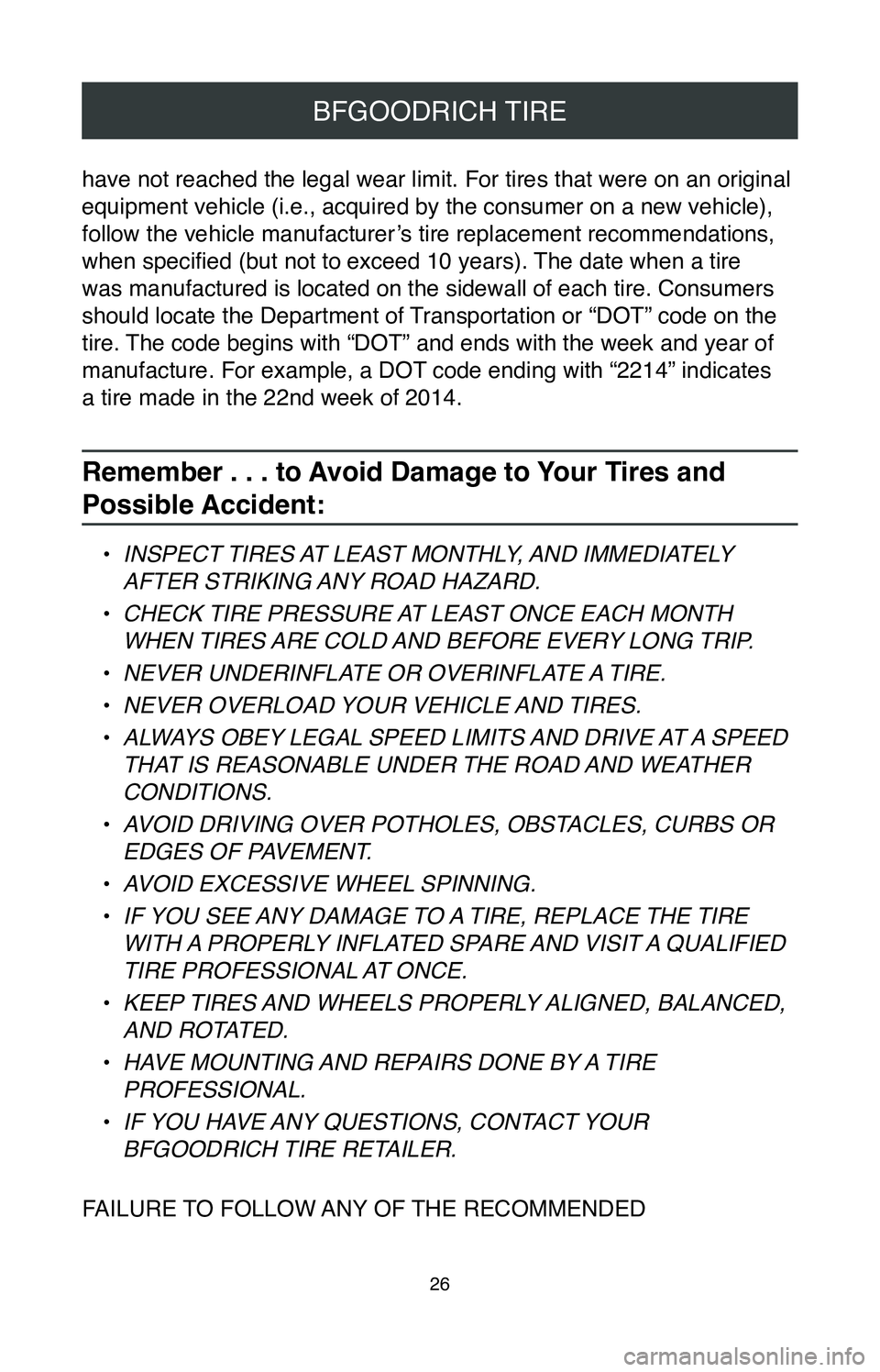
26
BFGOODRICH TIRE
have not reached the legal wear limit. For tires that were on an origina\
l
equipment vehicle (i.e., acquired by the consumer on a new vehicle),
follow the vehicle manufacturer’s tire replacement recommendations,
when specified (but not to exceed 10 years). The date when a tire
was manufactured is located on the sidewall of each tire. Consumers
should locate the Department of Transportation or “DOT” code on the
tire. The code begins with “DOT” and ends with the week and year of
manufacture. For example, a DOT code ending with “2214” indicates
a tire made in the 22nd week of 2014.
Remember . . . to Avoid Damage to Your Tires and
Possible Accident:
• INSPECT TIRES AT LEAST MONTHLY, AND IMMEDIATELY
AFTER STRIKING ANY ROAD HAZARD.
•
CHECK TIRE PRESSURE AT LEAST ONCE EACH MONTH
WHEN TIRES ARE COLD AND BEFORE EVERY LONG TRIP.
•
NEVER UNDERINFLATE OR OVERINFLATE A TIRE.
•
NEVER OVERLOAD YOUR VEHICLE AND TIRES.
•
ALWAYS OBEY LEGAL SPEED LIMITS AND DRIVE AT A SPEED
THAT IS REASONABLE UNDER THE ROAD AND WEATHER
CONDITIONS.
•
AVOID DRIVING OVER POTHOLES, OBSTACLES, CURBS OR
EDGES OF PAVEMENT.
•
AVOID EXCESSIVE WHEEL SPINNING.
•
IF YOU SEE ANY DAMAGE TO A TIRE, REPLACE THE TIRE
WITH A PROPERLY INFLATED SPARE AND VISIT A QUALIFIED
TIRE PROFESSIONAL AT ONCE.
•
KEEP TIRES AND WHEELS PROPERLY ALIGNED, BALANCED,
AND ROTATED.
•
HAVE MOUNTING AND REPAIRS DONE BY A TIRE
PROFESSIONAL.
•
IF YOU HAVE ANY QUESTIONS, CONTACT YOUR
BFGOODRICH TIRE RETAILER.
FAILURE TO FOLLOW ANY OF THE RECOMMENDED
Page 29 of 260
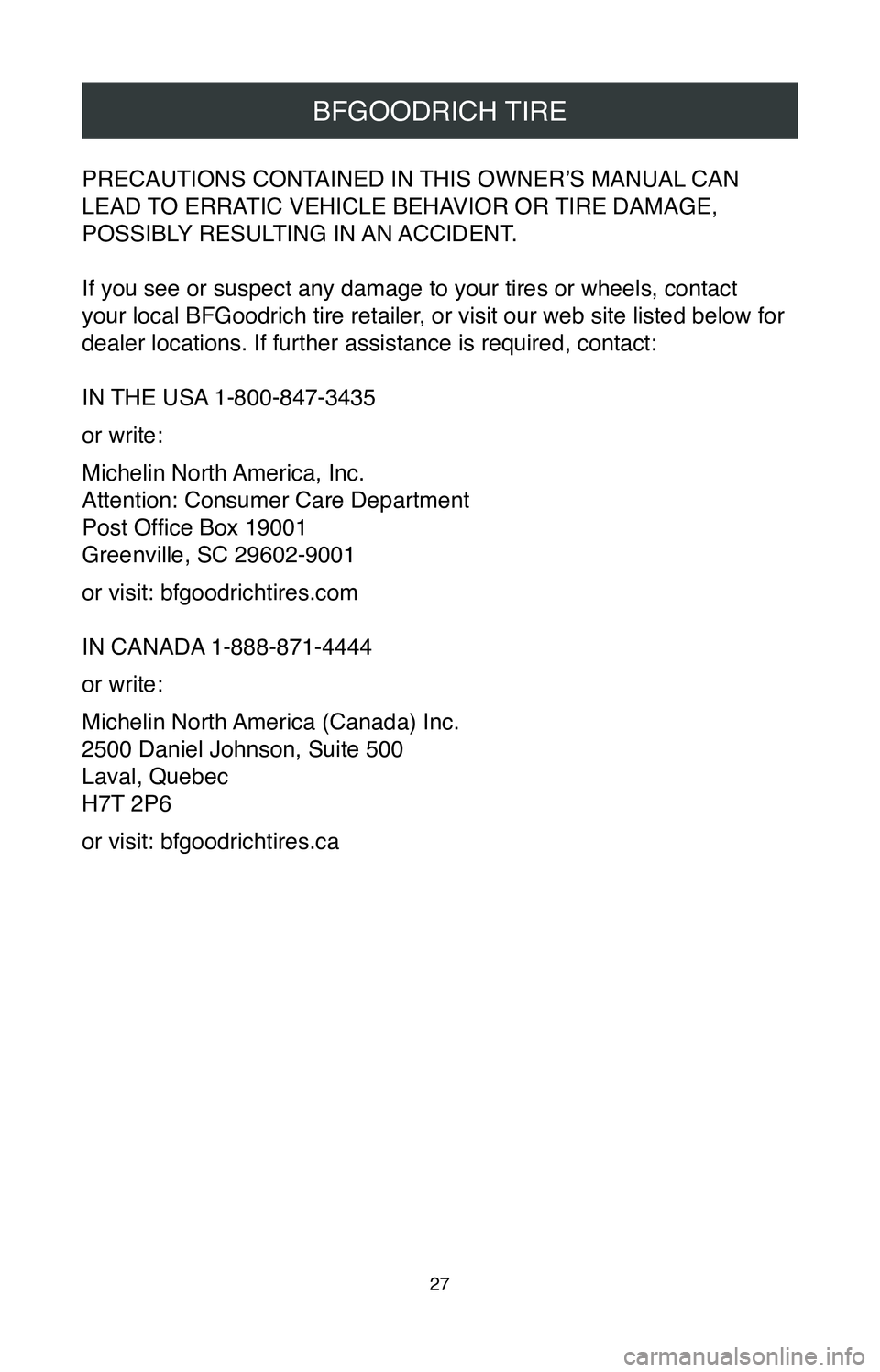
27
BFGOODRICH TIRE
PRECAUTIONS CONTAINED IN THIS OWNER’S MANUAL CAN
LEAD TO ERRATIC VEHICLE BEHAVIOR OR TIRE DAMAGE,
POSSIBLY RESULTING IN AN ACCIDENT.
If you see or suspect any damage to your tires or wheels, contact
your local BFGoodrich tire retailer, or visit our web site listed below for
dealer locations. If further assistance is required, contact:
IN THE USA 1-800-847-3435
or write:
Michelin North America, Inc.
Attention: Consumer Care Department
Post Office Box 19001
Greenville, SC 29602-9001
or visit: bfgoodrichtires.com
IN CANADA 1-888-871-4444
or write:
Michelin North America (Canada) Inc.
2500 Daniel Johnson, Suite 500
Laval, Quebec
H7T 2P6
or visit: bfgoodrichtires.ca
Page 35 of 260
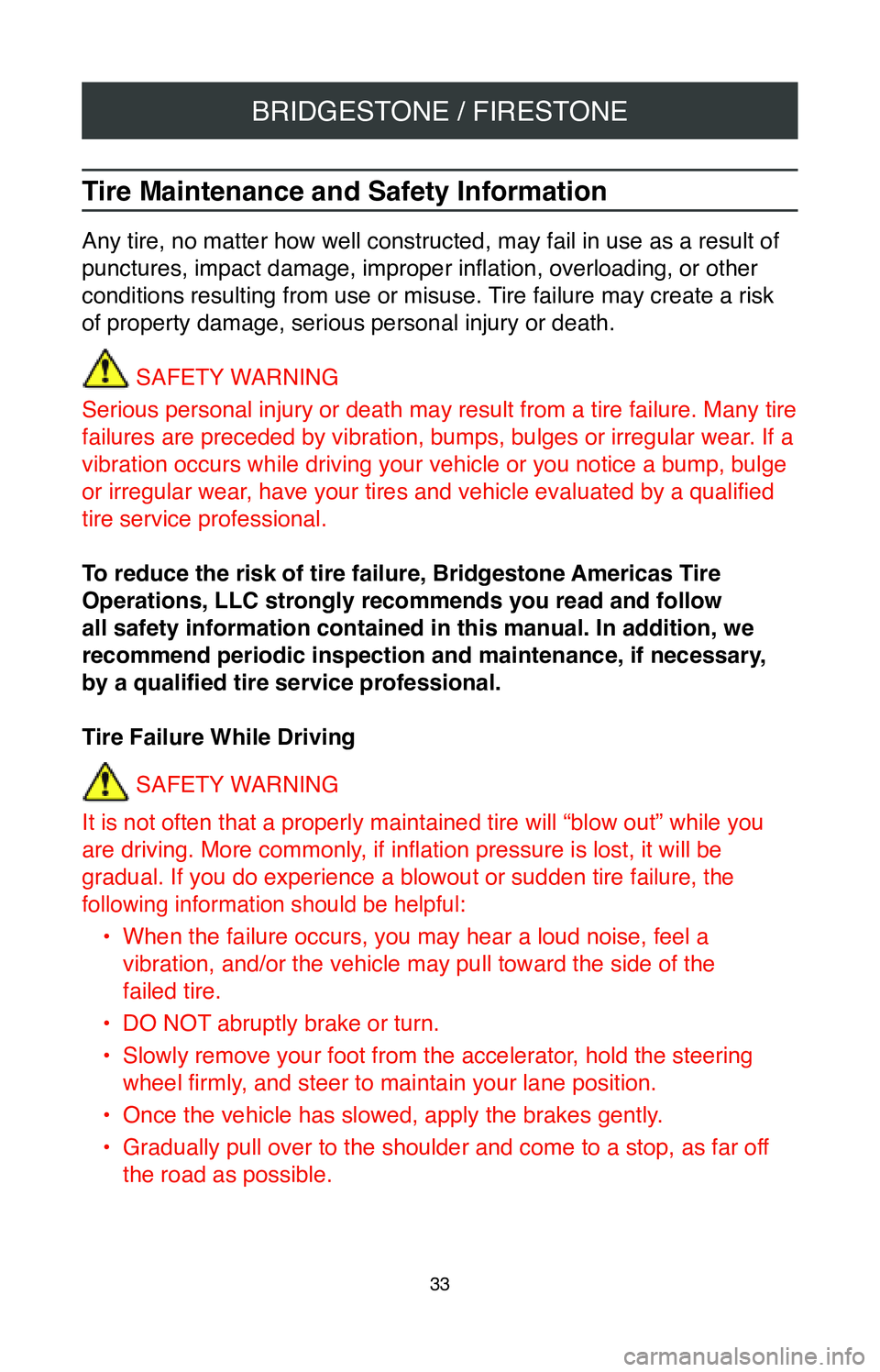
BRIDGESTONE / FIRESTONE
33
Tire Maintenance and Safety Information
Any tire, no matter how well constructed, may fail in use as a result of\
punctures, impact damage, improper inflation, overloading, or other
conditions resulting from use or misuse. Tire failure may create a risk
of property damage, serious personal injury or death.SAFETY WARNING
Serious personal injury or death may result from a tire failure. Many tire
failures are preceded by vibration, bumps, bulges or irregular wear. If a
vibration occurs while driving your vehicle or you notice a bump, bulge \
or irregular wear, have your tires and vehicle evaluated by a qualified
tire service professional.
To reduce the risk of tire failure, Bridgestone Americas Tire
Operations, LLC strongly recommends you read and follow
all safety information contained in this manual. In addition, we
recommend periodic inspection and maintenance, if necessary,
by a qualified tire service professional.
Tire Failure While Driving
SAFETY WARNING
It is not often that a properly maintained tire will “blow out” wh\
ile you
are driving. More commonly, if inflation pressure is lost, it will be
gradual. If you do experience a blowout or sudden tire
failure, the
following information should be helpful:
• When the failure occurs, you may hear a loud noise, feel a
vibration, and/or the vehicle may pull toward the side of the
failed tire.
•
DO NOT abruptly brake or turn.
•
Slowly remove your foot from the accelerator, hold the steering
wheel firmly, and steer to maintain your lane position.
•
Once the vehicle has slowed, apply the brakes gently.
•
Gradually pull over to the shoulder and come to a stop, as far off
the road as possible.
Page 38 of 260
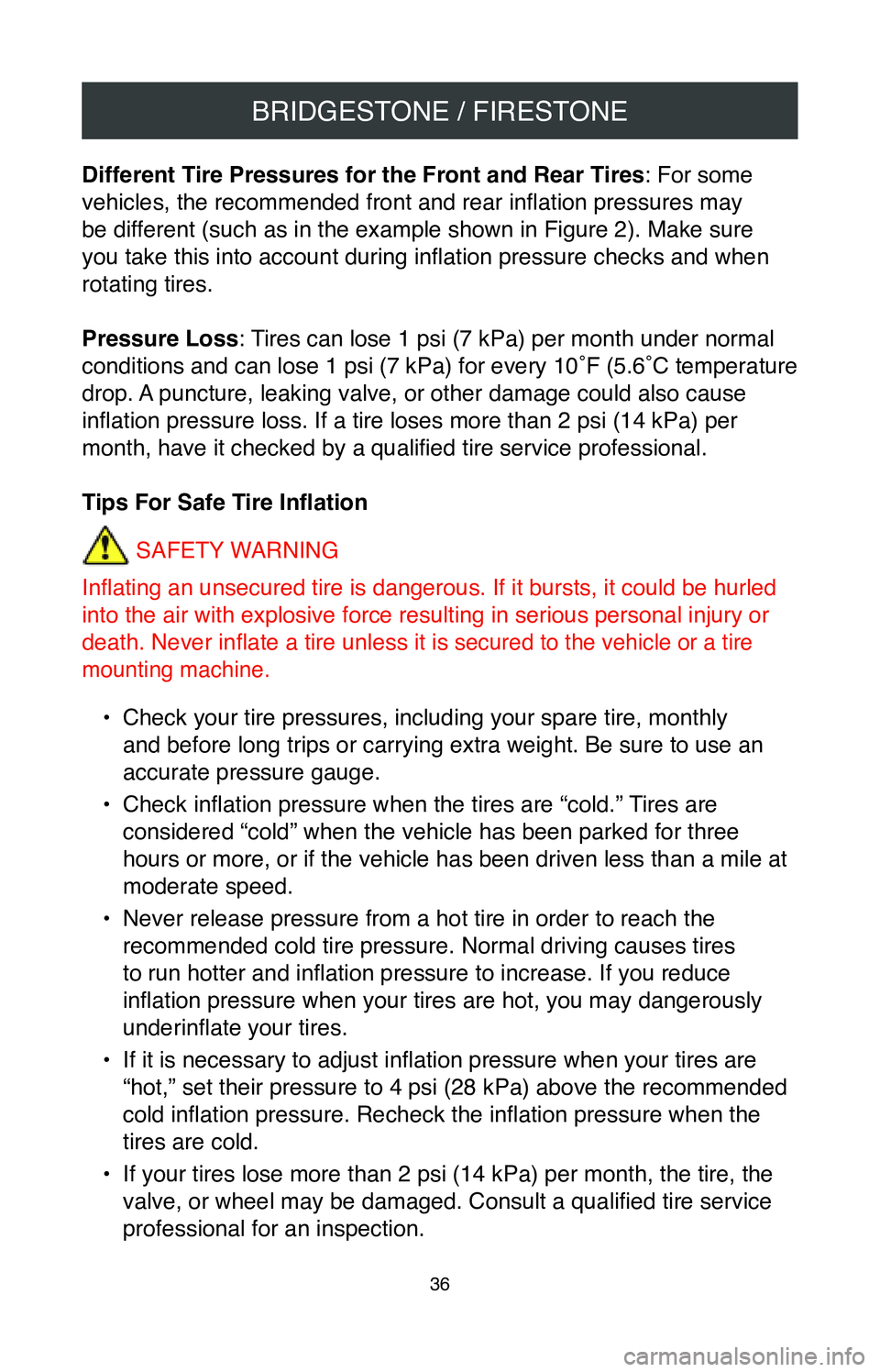
BRIDGESTONE / FIRESTONE
36
Different Tire Pressures for the Front and Rear Tires: For some
vehicles, the recommended front and rear inflation pressures may
be different (such as in the example shown in Figure 2). Make sure
you take this into account during inflation pressure checks and when
rotating tires.
Pressure Loss: Tires can lose 1 psi (7 kPa) per month under normal
conditions and can lose 1 psi (7 kPa) for every 10˚F (5.6˚C temperature
drop. A puncture, leaking valve, or other damage could also cause
inflation pressure loss. If a tire loses more than 2 psi (14 kPa) per
month, have it checked by a qualified tire service professional.
Tips For Safe Tire Inflation
SAFETY WARNING
Inflating an unsecured tire is dangerous. If it bursts, it could be hurled
into the air with explosive force resulting in serious personal injury or
death. Never inflate a tire unless it is
secured to the vehicle or a tire
mounting machine.
• Check your tire pressures, including your spare tire, monthly
and before long trips or carrying extra weight. Be sure to use an
accurate pressure gauge.
•
Check inflation pressure when the tires are “cold.” Tires are
considered “cold” when the vehicle has been parked for three
hours or more, or if the vehicle has been driven less than a mile at
moderate speed.
•
Never release pressure from a hot tire in order to reach the
recommended cold tire pressure. Normal driving causes tires
to run hotter and inflation pressure to increase. If you reduce
inflation pressure when your tires are hot, you may dangerously
underinflate your tires.
•
If it is necessary to adjust inflation pressure when your tires are
“hot,” set their pressure to 4 psi (28 kPa) above the recommended
cold inflation pressure. Recheck the inflation pressure when the
tires are cold.
•
If your tires lose more than 2 psi (14 kPa) per month, the tire, the
valve, or wheel may be damaged. Consult a qualified tire service
professional for an inspection.
Page 40 of 260
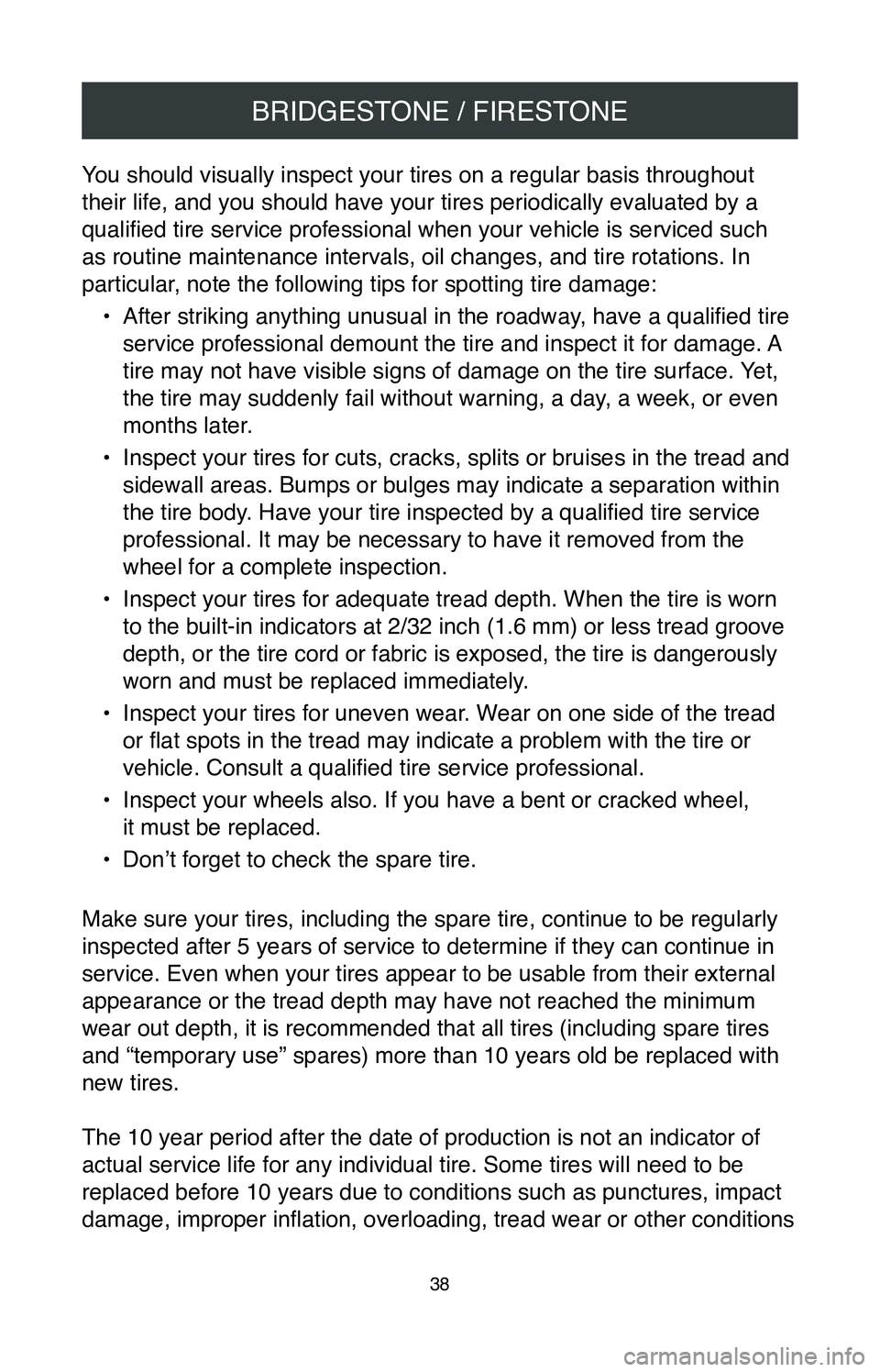
BRIDGESTONE / FIRESTONE
38
You should visually inspect your tires on a regular basis throughout
their life, and you should have your tires periodically evaluated by a
qualified tire service professional when your vehicle is serviced such
as routine maintenance intervals, oil changes, and tire rotations. In
particular, note the following tips for spotting tire damage:•
After striking anything unusual in the roadway, have a qualified tire
service professional demount the tire and inspect it for damage. A
tire may not have visible signs of damage on the tire surface. Yet,
the tire may suddenly fail without warning, a day, a week, or even
months later.
•
Inspect your tires for cuts, cracks, splits or bruises in the tread and \
sidewall areas. Bumps or bulges may indicate a separation within
the tire body. Have your tire inspected by a qualified tire service
professional. It may be necessary to have it removed from the
wheel for a complete inspection.
•
Inspect your tires for adequate tread depth. When the tire is worn
to the built-in indicators at 2/32 inch (1.6 mm) or less tread groove
depth, or the tire cord or fabric is exposed, the tire is dangerously
worn and must be replaced immediately.
•
Inspect your tires for uneven wear. Wear on one side of the tread
or flat spots in the tread may indicate a problem with the tire or
vehicle. Consult a qualified tire service professional.
•
Inspect your wheels also. If you have a bent or cracked wheel,
it must be replaced.
•
Don’t forget to check the spare tire.
Make sure your tires, including the spare tire, continue to be regularly\
inspected after 5 years of service to determine if they can continue in \
service. Even when your tires appear to be usable from their external
appearance or the tread depth may have not reached the minimum
wear out depth, it is recommended that all tires (including spare tires
and “temporary use” spares) more than 10 years old be replaced wi\
th
new tires.
The 10 year period after the date of production is not an indicator of
actual service life for any individual tire. Some tires will need to be \
replaced before 10 years due to conditions such as punctures, impact
damage, improper inflation, overloading, tread wear or other conditions
Page 41 of 260
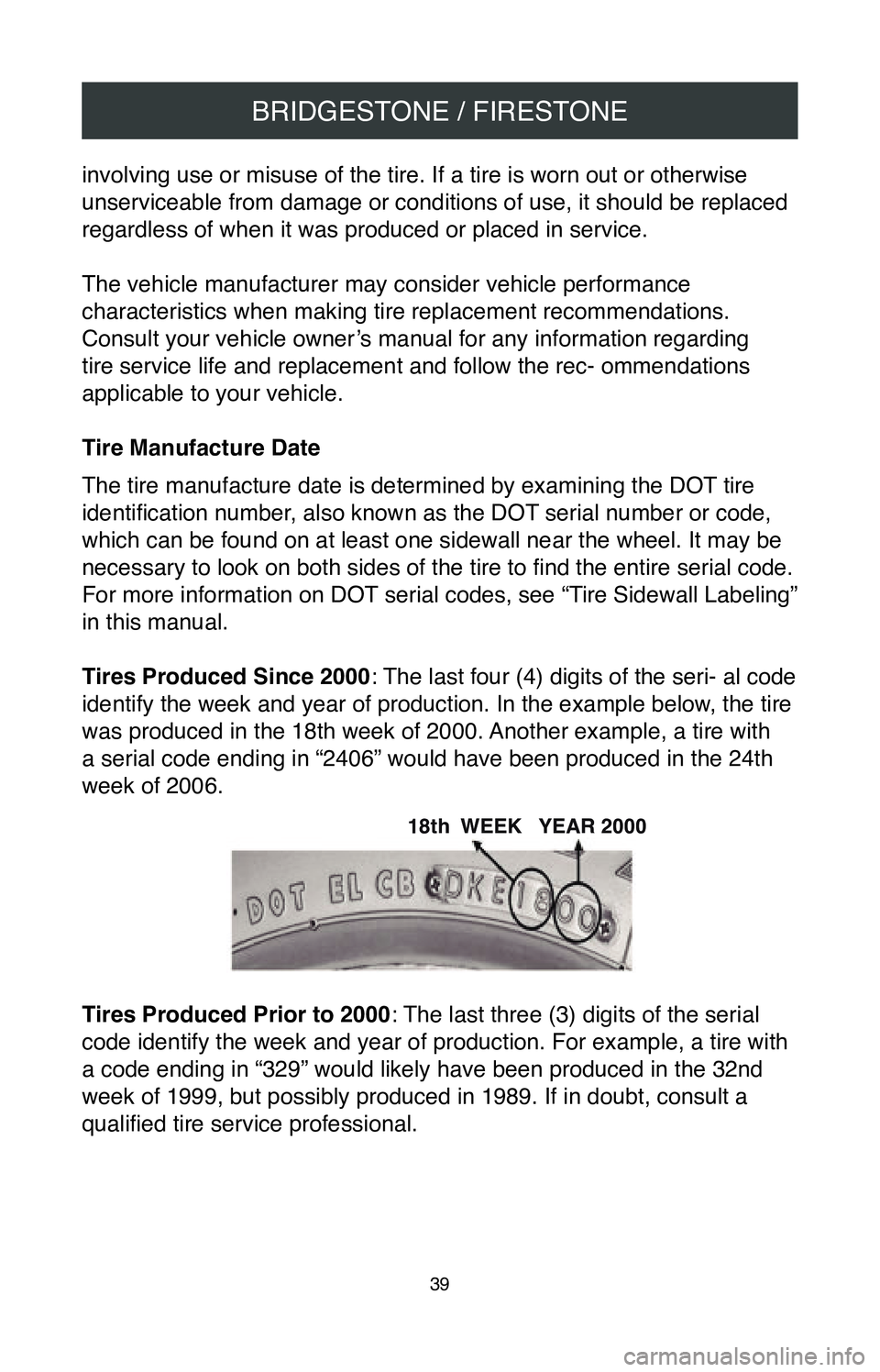
BRIDGESTONE / FIRESTONE
39
involving use or misuse of the tire. If a tire is worn out or otherwise \
unserviceable from damage or conditions of use, it should be replaced
regardless of when it was produced or placed in service.
The vehicle manufacturer may consider vehicle performance
characteristics when making tire replacement recommendations.
Consult your vehicle owner’s manual for any information regarding
tire service life and replacement and follow the rec- ommendations
applicable to your vehicle.
Tire Manufacture Date
The tire manufacture date is determined by examining the DOT tire
identification number, also known as the DOT serial number or code,
which can be found on at least one sidewall near the wheel. It may be
necessary to look on both sides of the tire to find the entire serial code.
For more information on DOT serial codes, see “Tire Sidewall Labeling”
in this manual.
Tires Produced Since 2000: The last four (4) digits of the seri- al code
identify the week and year of production. In the example below, the tire
was produced in the 18th week of 2000. Another example, a tire with
a serial code ending in “2406” would have been produced in the 24t\
h
week of 2006.
Tires Produced Prior to 2000: The last three (3) digits of the serial
code identify the week and year of production. For example, a tire with \
a code ending in “329” would likely have been produced in the 32nd\
week of 1999, but possibly produced in 1989. If in doubt, consult a
qualified tire service professional.
18th WEEK YEAR 2000
Page 42 of 260
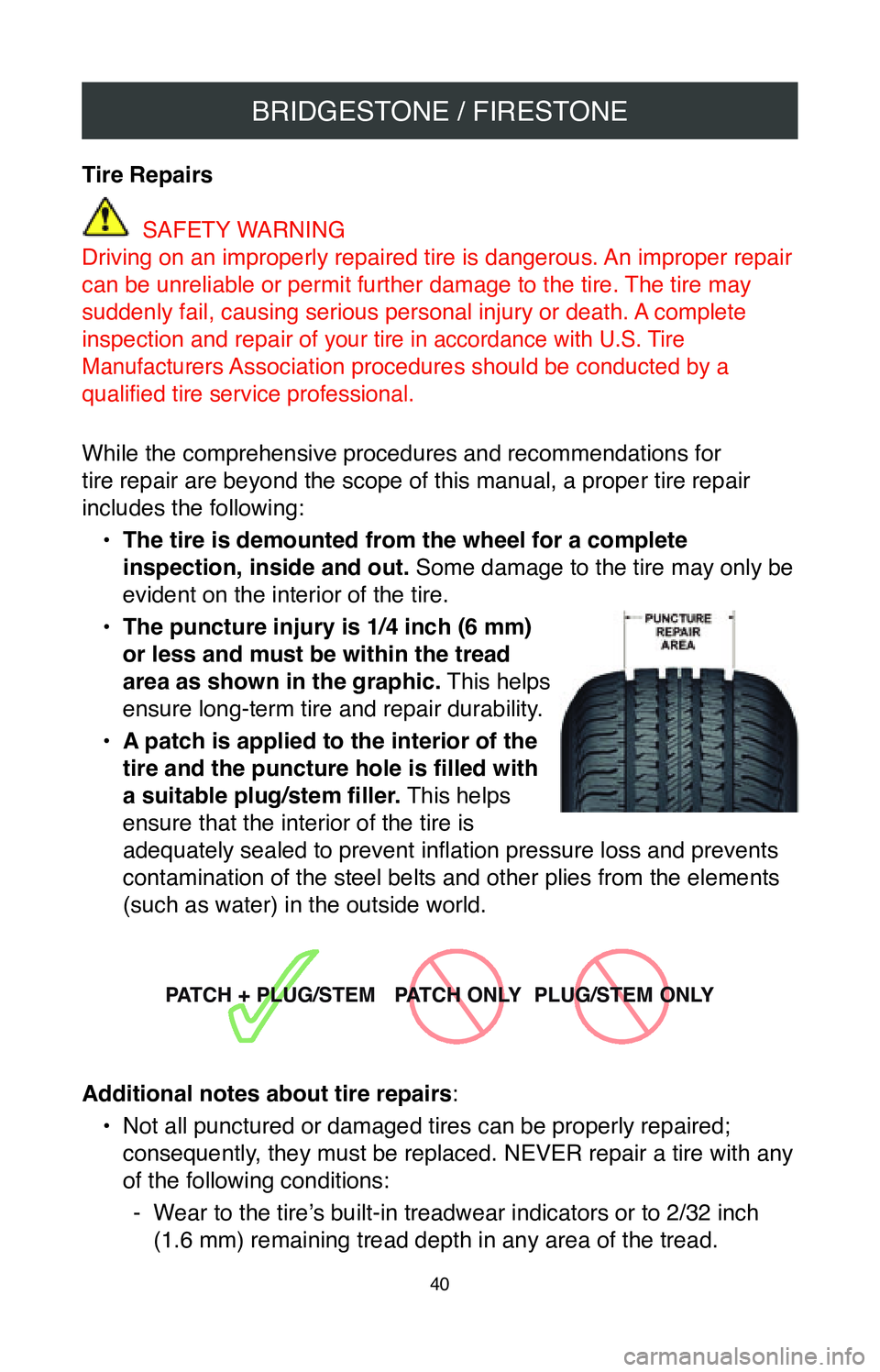
BRIDGESTONE / FIRESTONE
40
Tire Repairs
SAFETY WARNING
Driving on an improperly repaired tire is dangerous. An improper repair
can be unreliable or permit further damage to the tire. The tire may
suddenly fail, causing serious personal injury or death. A complete
inspection and repair of
your tire in accordance with U.S. Tire
Manufactur
ers Association procedures should be conducted by a
qualified tire service professional.
While the comprehensive procedures and recommendations for
tire repair are beyond the scope of this manual, a proper tire repair
includes the following:
•
The tire is demounted from the wheel for a complete
inspection, inside and out. Some damage to the tire may only be
evident on the interior of the tire.
•
The puncture injury is 1/4 inch (6 mm)
or less and must be within the tread
area as shown in the graphic. This helps
ensure long-term tire and repair durability.
•
A patch is applied to the interior of the
tire and the puncture hole is filled with
a suitable plug/stem filler. This helps
ensure that the interior of the tire is
adequately sealed to prevent inflation pressure loss and prevents
contamination of the steel belts and other plies from the elements
(such as water) in the outside world.
PATCH + PLUG/STEM PATCH ONLY PLUG/STEM ONLY
Additional notes about tire repairs :
•
Not all punctured or damaged tires can be properly repaired;
consequently, they must be replaced. NEVER repair a tire with any
of the following conditions:
- Wear to the tire’s built-in treadwear indicators or to 2/32 inch (1.6 mm) remaining tread depth in any area of the tread.
Page 43 of 260
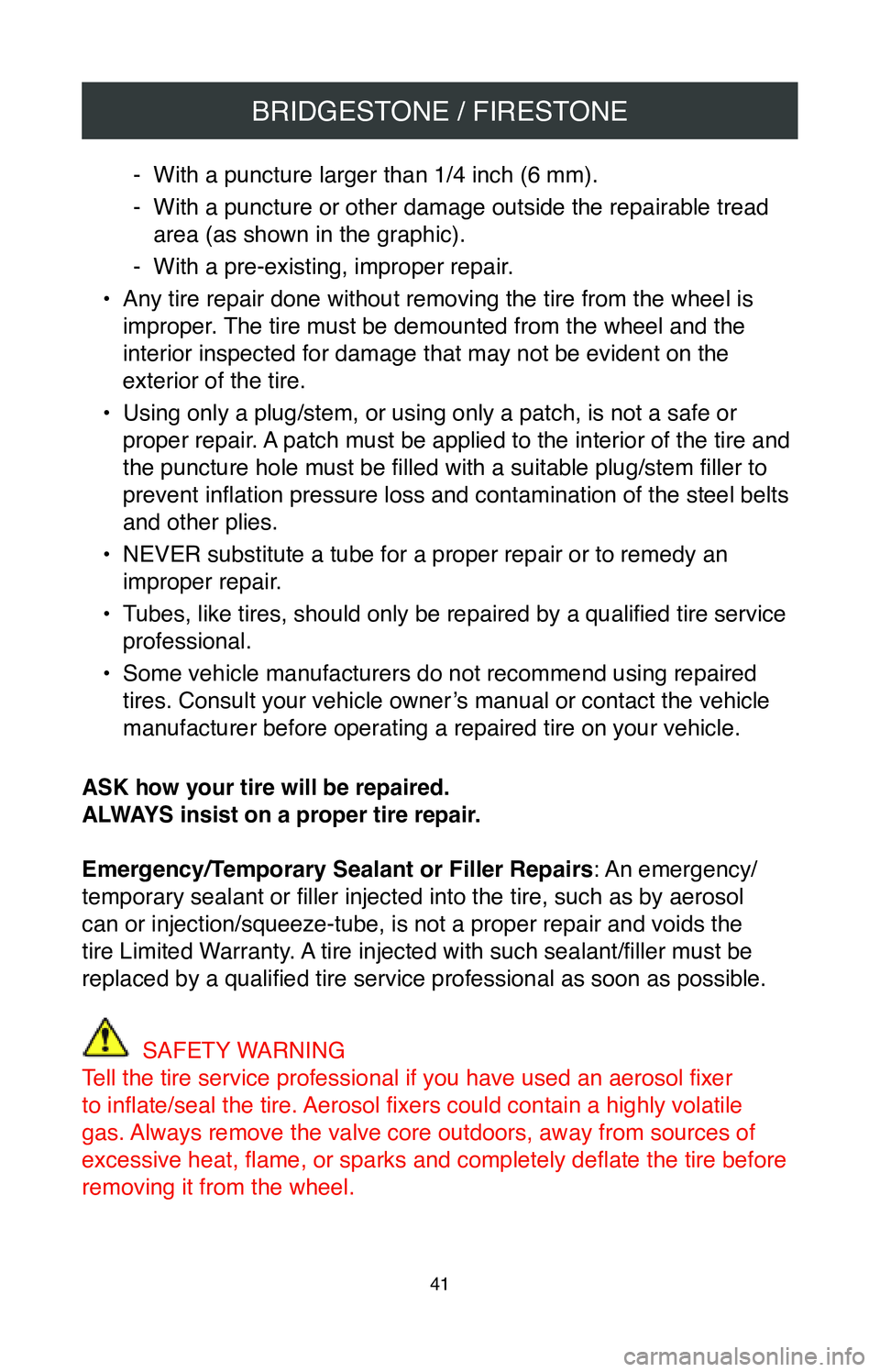
BRIDGESTONE / FIRESTONE
41
- With a puncture larger than 1/4 inch (6 mm).
-With a puncture or other damage outside the repairable tread
area (as shown in the graphic).
- With a pre-existing, improper repair.
•
Any tire repair done without removing the tire from the wheel is
improper. The tire must be demounted from the wheel and the
interior inspected for damage that may not be evident on the
exterior of the tire.
•
Using only a plug/stem, or using only a patch, is not a safe or
proper repair. A patch must be applied to the interior of the tire and
the puncture hole must be filled with a suitable plug/stem filler to
prevent inflation pressure loss and contamination of the steel belts
and other plies.
•
NEVER substitute a tube for a proper repair or to remedy an
improper repair.
•
Tubes, like tires, should only be repaired by a qualified tire service
professional.
•
Some vehicle manufacturers do not recommend using repaired
tires. Consult your vehicle owner’s manual or contact the vehicle
manufacturer before operating a repaired tire on your vehicle.
ASK how your tire will be repaired.
ALWAYS insist on a proper tire repair.
Emergency/Temporary Sealant or Filler Repairs: An emergency/
temporary sealant or filler injected into the tire, such as by aerosol
can or injection/squeeze-tube, is not a proper repair and voids the
tire Limited Warranty. A tire injected with such sealant/filler must be
replaced by a qualified tire service professional as soon as possible.
SAFETY WARNING
Tell the tire service professional if you have used an aerosol fixer
to inflate/seal the tire. Aerosol fixers could contain a highly volatile
gas. Always remove the valve core outdoors, away from sources of
excessive heat, flame, or sparks and completely deflate the tire before
removing it from the wheel.
Page 44 of 260
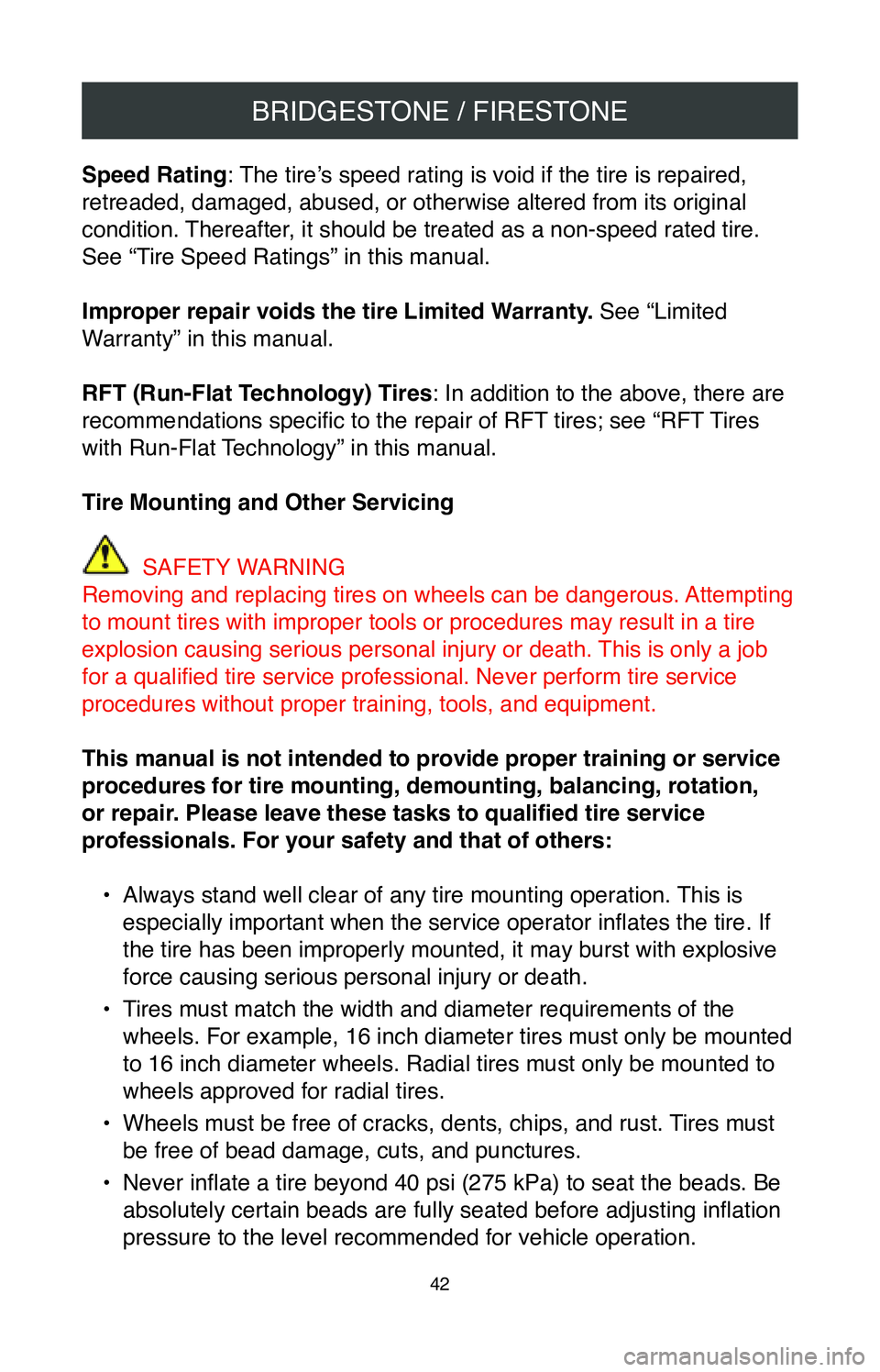
BRIDGESTONE / FIRESTONE
42
Speed Rating: The tire’s speed rating is void if the tire is repaired,
retreaded, damaged, abused, or otherwise altered from its original
condition. Thereafter, it should be treated as a non-speed rated tire.
See “Tire Speed Ratings” in this manual.
Improper repair voids the tire Limited Warranty. See “Limited
Warranty” in this manual.
RFT (Run-Flat Technology) Tires: In addition to the above, there are
recommendations specific to the repair of RFT tires; see “RFT Tires
with Run-Flat Technology” in this manual.
Tire Mounting and Other Servicing
SAFETY WARNING
Removing and replacing tires on wheels can be dangerous. Attempting
to mount tires with improper tools or procedures may result in a tire
explosion causing serious personal injury or death. This is only a job
for a qualified tire service professional. Never perform tire service
procedures without proper training, tools, and equipment.
This manual is not intended to provide proper training or service
procedures for tire mounting, demounting, balancing, rotation,
or repair. Please leave these tasks to qualified tire service
professionals. For your safety and that of others:
•
Always stand well clear of any tire mounting operation. This is
especially important when the service operator inflates the tire. If
the tire has been improperly mounted, it may burst with explosive
force causing serious personal injury or death.
•
Tires must match the width and diameter requirements of the
wheels. For example, 16 inch diameter tires must only be mounted
to 16 inch diameter wheels. Radial tires must only be mounted to
wheels approved for radial tires.
•
Wheels must be free of cracks, dents, chips, and rust. Tires must
be free of bead damage, cuts, and punctures.
•
Never inflate a tire beyond 40 psi (275 kPa) to seat the beads. Be
absolutely certain beads are fully seated before adjusting inflation
pressure to the level recommended for vehicle operation.
Page 45 of 260
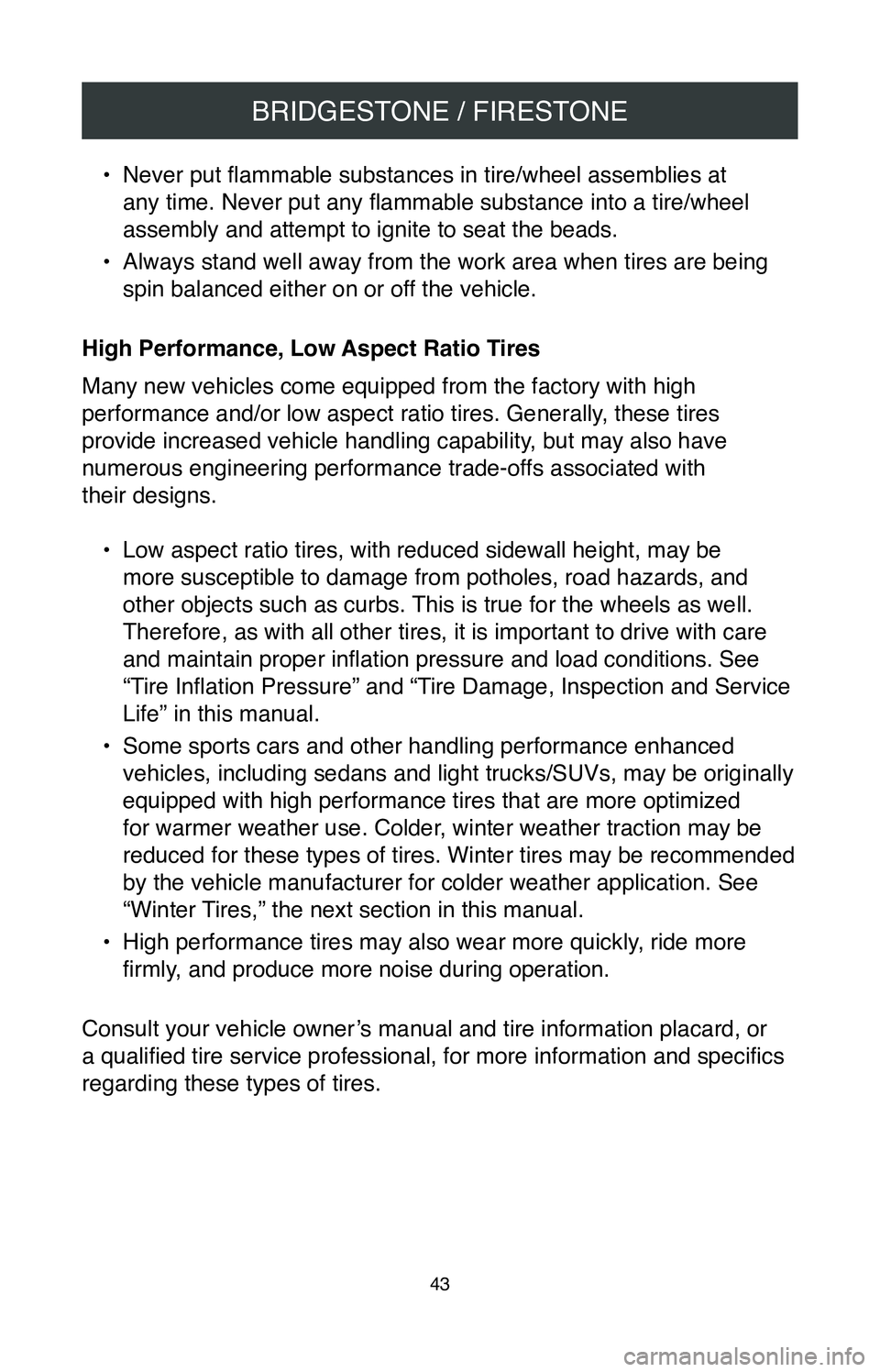
BRIDGESTONE / FIRESTONE
43
• Never put flammable substances in tire/wheel assemblies at
any time. Never put any flammable substance into a tire/wheel
assembly and attempt to ignite to seat the beads.
•
Always stand well away from the work area when tires are being
spin balanced either on or off the vehicle.
High Performance, Low Aspect Ratio Tires
Many new vehicles come equipped from the factory with high
performance and/or low aspect ratio tires. Generally, these tires
provide increased vehicle handling capability, but may also have
numerous engineering performance trade-offs associated with
their designs. •
Low aspect ratio tires, with reduced sidewall height, may be
more susceptible to damage from potholes, road hazards, and
other objects such as curbs. This is true for the wheels as well.
Therefore, as with all other tires, it is important to drive with care
and maintain proper inflation pressure and load conditions. See
“Tire Inflation Pressure” and “Tire Damage, Inspection and Service
Life” in this manual.
•
Some sports cars and other handling performance enhanced
vehicles, including sedans and light trucks/SUVs, may be originally
equipped with high performance tires that are more optimized
for warmer weather use. Colder, winter weather traction may be
reduced for these types of tires. Winter tires may be recommended
by the vehicle manufacturer for colder weather application. See
“Winter Tires,” the next section in this manual.
•
High performance tires may also wear more quickly, ride more
firmly, and produce more noise during operation.
Consult your vehicle owner’s manual and tire information placard, or
a qualified tire service professional, for more information and specifics
regarding these types of tires.